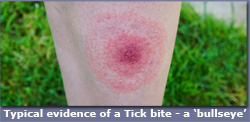 |
|
|
|
Postal and Engineering workers at risk Both the CWU and Unionsafety have issued each year information about tick-borne diseases of which Lyme Disease is perhaps the most common. As far back as 2020, the CWU's Health, Safety and Environment National Officer Dave Joyce, warned of new tick-borne illnesses being found in the UK. Indeed, the Unionsafety E-Library contains documents going back to 2009 on the subject of Lyme Disease and Tick bites. Now, a new risk assessment, published by a multi-agency cross-government committee, reports that tick borne encephalitis is now likely to be present in England, with one case having been reported in Scotland. The UK Health Security Agency (UKHSA) have today released the following press release detailing the risk of Tick-borne diseases, especially that of Tick-Borne Encephalitis (TBEV) which was first seen in the UK in 2019. The risk assessment is based on both human cases and the detection of the virus in ticks in several areas of the country. The risk to the general public in the UK remains very low. Removing Ticks are best done by someone with you at the time of the bite being discovered. Details on how to remove a Tick can be read below this press release.
You can download the Human Animal Infections and Risk Surveillance (HAIRS) Risk Assessment process from the UK Gov website, here How To Remove A Tick Don’t panic. Remove the tick as soon as possible. Even if the tick is carrying infection it is very unlikely to transmit it in the first few hours of its feed, so early removal is a very effective prevention measure. Grasp the tick as close to the skin as possible, using fine tweezers or finger nails, and pull firmly and steadily without jerking or twisting. Don’t rush. Try not to squeeze or crush the tick’s body. Sometimes, tick mouth parts can break off from the body and remain in the skin. This is unlikely to increase the risk of Lyme disease, but common skin organisms could cause infection. Apply a skin disinfectant once the tick has been removed. Specially designed tick extractors are available from veterinary practices and pet shops. They are inexpensive and particularly useful for people who are likely to have frequent tick exposure. Never apply heat, e.g. lighted cigarette ends or match heads, to attached ticks. Do not use chemicals such as alcohol, nail polish remover, petroleum jelly or aromatic oils to ticks prior to removal. These substances could increase infection risk by stimulating the tick to regurgitate saliva into the bite wound. Check for redness around the site of the bite. If you are concerned in any way or become unwell, see your doctor as soon as possible. See the New Forest information leaflet, available from the Unionsafety E-Library for further information. Source: UKHSA / NHS / unionsafety / CWU LTB 431/2020 See also: CWU Issues Urgent Warning Of New Tick-Borne Diseases Now In UK Lyme Disease – Patients Languish While Facts Are Buried Lyme Disease Invisible And Misdiagnosed Devastates Sufferers As NHS And Govt Remain Idle
|

 There have been 3 cases of probable or confirmed tick-borne encephalitis acquired in England since 2019, including one linked to the Yorkshire area in 2022. This case in 2022 is the first confirmed case in England. The virus has also been detected previously in the Hampshire and Dorset, and Norfolk and Suffolk border areas but may also be present elsewhere as the tick species that carries the virus is widespread in the UK.
There have been 3 cases of probable or confirmed tick-borne encephalitis acquired in England since 2019, including one linked to the Yorkshire area in 2022. This case in 2022 is the first confirmed case in England. The virus has also been detected previously in the Hampshire and Dorset, and Norfolk and Suffolk border areas but may also be present elsewhere as the tick species that carries the virus is widespread in the UK. has symptoms of meningitis:
has symptoms of meningitis: